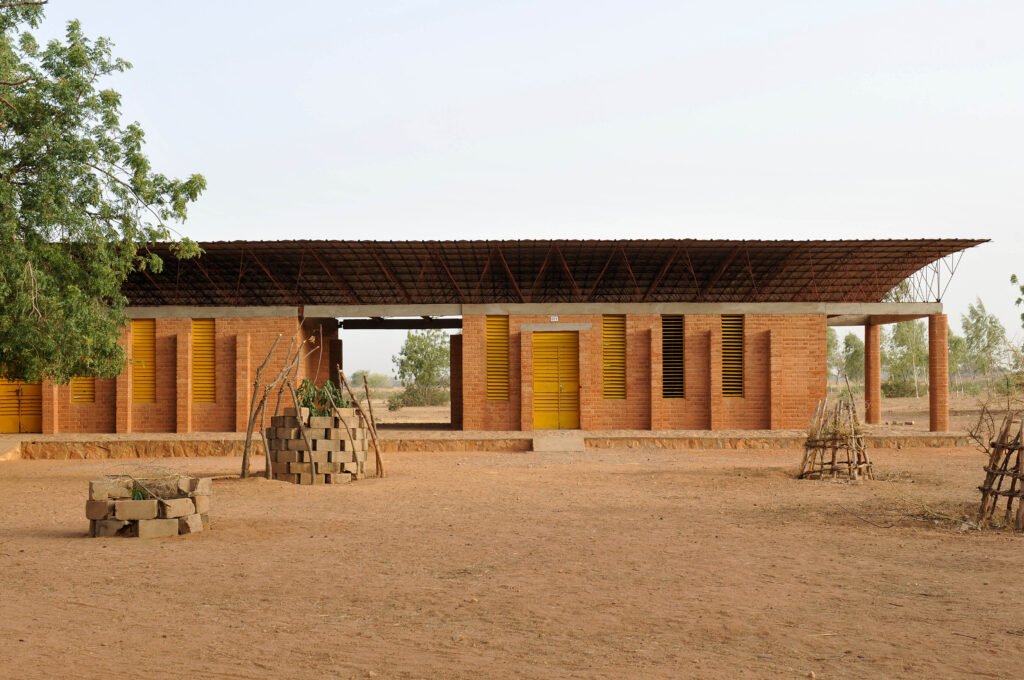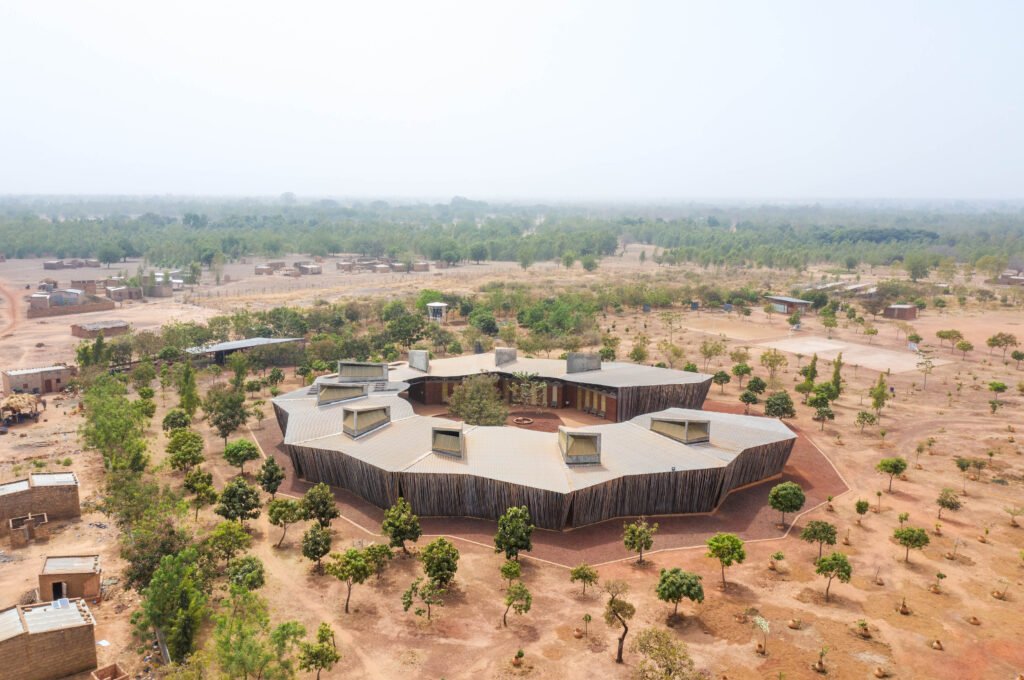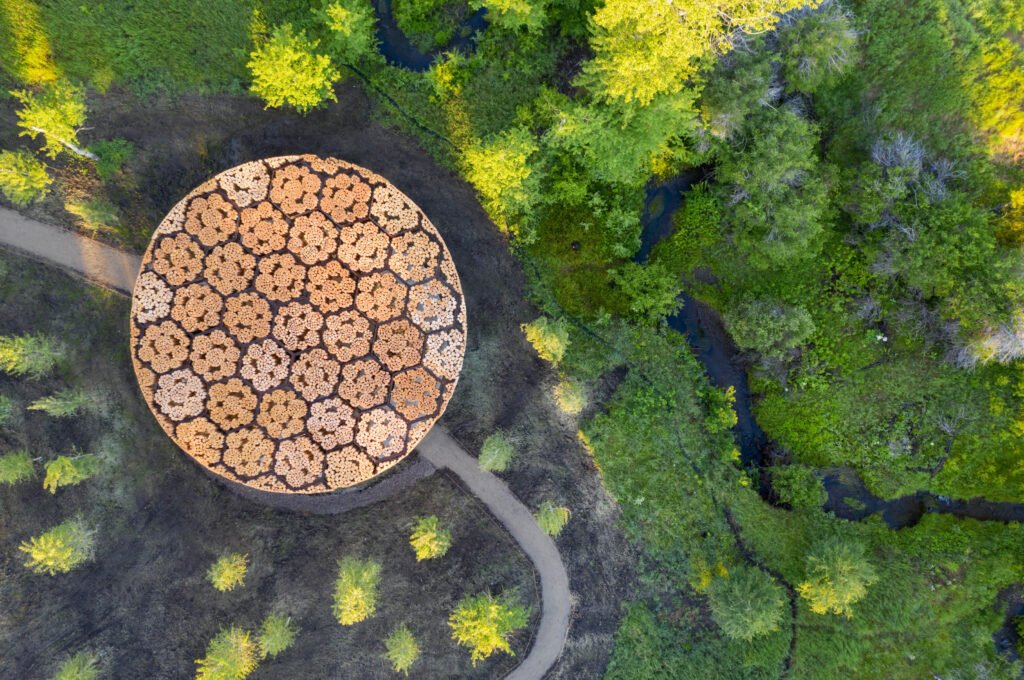Words Gabbie dela Cruz
Photo and Information Kéré Architecture and Pritzker Architecture Prize


Community building, social justice, sustainability, and the power of materiality are prevalent qualities in 2022 Pritzker Prize Laureate’s Francis Kèré’s works. Since the foundation of his practice in 2005, the architect has gone on to put his heart into his art, never neglecting his roots and always carrying a sense of locality in his design process. This year’s Pritzker jury cited that “in a world in crisis, amidst changing values and generations”, Kéré “reminds us of what has been, and will undoubtedly continue to be a cornerstone of architectural practice: a sense of community and narrative quality, which he himself is so able to recount with compassion and pride.”
Below is a selection of seven Kéré Architecture projects that reflect their utopian and pragmatic philosophy, where one can glean and draw inspiration with regard to transforming locality into a universal possibility.
1. Gando Primary School, 2001
Intended to expand the sporadic complex of schools in the province of Boulgou, the Gando Primary School was built with a clay/cement hybrid that created structurally robust bricks. This clay material is “abundantly available in the region and traditionally used in house building” and addressed the possible thermal heat issue given the locale.
Francis Kéré designed this elongated rectangular structure with an overhanging roof that pulls away from the learning space of the interior. This mechanism allowed the building to solve two of the most recurrent problems in educational buildings within the area, which are poor lighting and proper ventilation. By its essence and presence, Gando Primary School proves that Kéré’s work is a “fruit of circumstances”, an initial response that led to a legacy of cultural sensitivity.


2. National Park of Mali, 2010
Clad with natural stone from the region, the buildings inside the 35,000 sqm site of the National Park of Mali are symbols of celebration to mark what was then the country’s 50th anniversary of independence. It was “refurbished and reopened with the addition of several new amenities,” with Kéré Architecture designing “a number of built interventions throughout the park, including new points of entry, a youth and sports center, a restaurant, public toilets, and kiosks.”
Kéré Architecture says that all buildings within the scheme follow the same architectural language, evident in the color palette, materials, and patterns used. The buildings also connect through a pedestrian network, “which also connects with the National Museum, as well as various natural attractions.” The National Park of Mali’s concept substantiates the 2022 Pritzker Prize’s jury’s words that Kéré’s philosophy “provides a narrative in which architecture can become a source of continued and lasting happiness and joy.”


3. Lycée Schorge, 2014-2016
Another educational institution by Kéré, the Lycée Schorge boasts an innovative way of showcasing building materials sourced within the vicinity. Bricks of locally-sourced laterite stones make up the walls of each of the nine modules within the structure, forming a radial courtyard that shields the central space from the wind and dust particles.
Wrapping around the classrooms is a “secondary façade” made of local eucalyptus wood. This appears as a “transparent fabric” that allows a play of light while simultaneously sheltering various intermediary spaces “where students can gather informally while waiting for their classes.” Lycée Schorge, like The Gando Primary School, is living proof that Kéré understands an apparently simple goal, which is to “make it possible for children to attend school comfortably.”


4. Leó Doctors’ Housing, 2016-2018
The Leó Doctors’ Housing is part of Léo Surgical Clinic and Health Centre’s vision of providing not only accommodation for volunteers and resident staff but also of establishing an avenue for exchange and discourse between visiting medical specialists and local doctors. Five separate apartments follow a modular system that consists of single bedrooms, private living rooms, gardens, outdoor terraces, and shared amenities.
Concrete blocks ensure the privacy and security of the communal courtyard and add to the structural integrity of the housing complex. The Léo Doctors’ Housing is an interplay of spaces, with a “cooling system of drainage ponds that absorb and retain rainwater,” a “singular vault made of CEB with the ends left open for ventilation and to allow daylight to penetrate,” and an elevated “roof of corrugated metal sheeting” that “protects the interiors from excessive heat while sheltering them from rain and sun.” Indeed, “Kéré’s buildings, for and with communities, are directly of those communities – in their making, their materials, their programs, and their unique characters.”


5. Xylem, 2019
Xylem was designed by Francis Kéré as “a gathering pavilion for the Tippet Rise Art Center in Montana, United States.” Directly inspired by its name, the pavilion’s roof structure is packed with modular hexagonal bundles that are reminiscent of a tree’s vital internal layers. It is one of Kéré’s works that has “presence without pretense and an impact shaped by grace,” with it being a quiet shelter that allows visitors to “converse, or sit and contemplate in solitude.”
Apart from its nature-inspired aesthetic, Xylem is literally marked by the boundaries of nature, with it nestled in “a clearing surrounded by aspen trees, facing a small creek.” It also is a rendezvous in a geographical sense, as it acts as “a link between Montana in the US and Burkina Faso, as it was built in parallel with the Naaba Belem Goumma Secondary School in Francis Kéré’s birthplace, Gando.”


6. Startup Lions Campus, 2019-2021
Providing 100 new workstations, the Startup Lions Campus is a response to the growing need for employment within the area. Kéré Architecture says that this 1,416 sqm site “is the first step in an ambitious vision of spreading ICT networks in remote areas,” allowing “young entrepreneurs to thrive professionally without having to leave their place of origin.”
Locally-sourced quarry stone with a plaster finish was used as the primary material for the employment building. The design mimics that of “towering mounds built by termite colonies in the region”, demonstrating a stack effect that “naturally cools the main working spaces by extracting warm air upwards.” Kéré’s design for the Startup Lions Campus “reminds us of the necessary struggle to change unsustainable patterns of production and consumption, as we strive to provide adequate buildings and infrastructure for billions in need.”


7. Benin National Assembly (under construction)
In 2019, the parliament of the Republic of Benin entrusted Kéré Architecture to build a new National Assembly at Porto-Novo. The construction of the project is in response to the National Assembly outgrowing its old legislative building, which “dates back to the colonial era.” Kéré’s concept borrows the physical attributes of a palaver tree, whose shade was historically used by West Africans for communal discourse and engagement.
The National Assembly of Benin is envisioned to stand as a four-corner structure that sits on central curves that resemble that of a tree canopy. Aside from inspiring its physical identity and design, borrowing age-old wisdom from the palaver tree will also showcase the “values of democracy and the cultural identity of its citizens.”


The world is changing at a blinding pace, but despite the shift in needs and context, architecture’s mandate stays the same: to respond and serve the needs, as well as be representative of its users. The Pritzker has taken the right, and admittedly long-overdue step, in recognizing the voice of African designers with their awarding of Kéré, helping reveal to the world an architectural approach that is intimately tied to culture, community, and nature in a manner that is often humble and intensely sensitive, qualities that are in short supply in today’s spaces.
It is also about the time that individuals and communities amplify head-on more diverse voices whose standards and principles meet the ultimate goal of designing spaces and places that encourage beauty, progress, and life itself. •

